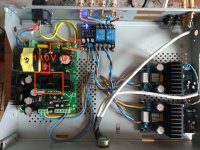Hi,
I got this SMPS from aliexpress to power a class d amplifier assembly. When I touched one of its heatsinks to try the temperature, it gave me a mild electric shock. Happily I used just one finger without touching anything else. Subsequently I measured 140V DC across the heatsink and ground. I see this SMPS is used among many projects here in the forums, but didn't spot anything mentioned about this issue.
Is this normal? Is it by design or is there some fault with the unit?
I got this SMPS from aliexpress to power a class d amplifier assembly. When I touched one of its heatsinks to try the temperature, it gave me a mild electric shock. Happily I used just one finger without touching anything else. Subsequently I measured 140V DC across the heatsink and ground. I see this SMPS is used among many projects here in the forums, but didn't spot anything mentioned about this issue.
Is this normal? Is it by design or is there some fault with the unit?
Attachments
For proper circulation of the AC currents trough the isolation of the transistor, MOSFET or IC, the heatsink must be returned to the quieter side of the primary, say the positive or negative (Commonly the last) of the mains rectified before the line filter. So the circuit is properly designed. Earthing this heatsink will degrade very severely the AC performance and the EMI of the supply. Simply keep the hand far from it.
Notice there is a very visible white dotted line, punctuated by "alarm/danger/attention/hazard !!!" exclamation signs inside of warning triangles,

separating the "safe" area on bottom from the DEADLY/Hot area on top, which is about 80% of the power supply.
You must NOT repeat NOT touch ANYTHING above the dotted white line , period.
I am certain supply instructions say so, but hey, who reads instructions?

Touching a live voltage heatsink to check temperature?
Next time you might check a Lion´s hunger by putting your hand inside its mouth

separating the "safe" area on bottom from the DEADLY/Hot area on top, which is about 80% of the power supply.
You must NOT repeat NOT touch ANYTHING above the dotted white line , period.
I am certain supply instructions say so, but hey, who reads instructions?
Touching a live voltage heatsink to check temperature?
Next time you might check a Lion´s hunger by putting your hand inside its mouth
Last edited:
You must NOT repeat NOT touch ANYTHING above the dotted white line , period.
Unless he wants to make his hairs curly for free.
Take a reading here, as an example:
https://www.emcstandards.co.uk/files/emc_techniques_for_heatsinks_july_2010.pdf
https://www.emcstandards.co.uk/files/emc_techniques_for_heatsinks_july_2010.pdf
Thanks for all the information. Curly hair and wising up accomplished 
I knew that the high voltage are of the pcb is marked to indicate caution, but I was shocked to meet a 5cm exposed heatsink to carry high voltages without an eminent warning sign.
Is it a good practice to cover the case internally above the heatsink with some insulation material? If something heavy deforms it, it may contact the heatsink.
Thanks again!
I knew that the high voltage are of the pcb is marked to indicate caution, but I was shocked to meet a 5cm exposed heatsink to carry high voltages without an eminent warning sign.
Is it a good practice to cover the case internally above the heatsink with some insulation material? If something heavy deforms it, it may contact the heatsink.
Thanks again!
As I make many of my SMPS's myself, and they are generally a one-off, I use a simple expedient to protect myself and the equipments against mishaps during the debugging, etc: I tie the heatsink to the cold side of the primary (Vss or GND), but I use a Y cap to do it: it acts as a short for HF, but in case of an accidental contact with me or the oscilloscope GND, the current is limited to tens or hundreds µA at most: completely safe.
See an example here (C22 for the sink, C23 for the screen):
A "supply-center" for testing tube projects
See an example here (C22 for the sink, C23 for the screen):
A "supply-center" for testing tube projects
Thanks for all the information. Curly hair and wising up accomplished
I knew that the high voltage are of the pcb is marked to indicate caution, but I was shocked to meet a 5cm exposed heatsink to carry high voltages without an eminent warning sign.
Is it a good practice to cover the case internally above the heatsink with some insulation material? If something heavy deforms it, it may contact the heatsink.
Thanks again!
Fully agree.
Offline SMPS sold to the general public "should" be inside a grounded perforated metal case, as PC supplies are, which in the quantities they sell cost cents, OR at least , as you say, *prominently* mark the danger area.
Say, spraying some red/yellow/orange fluo paint on it, just a mist , but very noticeable.
A few boards not only print the white dotted line such as this one, but criss cross the danger area with thin white lines.
These at least make the white line more prominent and write Hot/Cold on either side
An externally hosted image should be here but it was not working when we last tested it.
And there is *one* capacitor bridging both areas, which still has its own white line below.
Just curious, can you upload here "instructions" accompanying your EBay SMPS?
I´d love to see what they say ... if anything at all.
No instructions were accompanying the module. Just the module in a plastic bubble wrap. This is the most common practice on every cheap module I have received from China. All the information I have access to is at the web page of the item:
NEW 500W amplifier switching power supply board dual voltage PSU +/ 55V +/ 60VDC +/ 50VDC-in Amplifier from Consumer Electronics on Aliexpress.com | Alibaba Group
NEW 500W amplifier switching power supply board dual voltage PSU +/ 55V +/ 60VDC +/ 50VDC-in Amplifier from Consumer Electronics on Aliexpress.com | Alibaba Group
I am happy to have come across this thread because I had a similar experience... A couple of years ago I bought a bunch of the surplus ABLETEC +/-53V power supplies for some DIY projects. With one such project powered up and the amp case open I received a good shock from the aluminum bar that runs along one side of the PS and to which the devices are connected, albeit with what looked like some insulator material. I had assumed that this bar would be connected to the chassis and that it would be safe to touch that region, which was definitely not the case. We live and learn, and hopefully do not die in the process.
Last edited:
Earth grounding a heat sink which helps switching devices off line is not recommended. They MUST be AC 50/60Hz live because of the HF current paths to the quieter side of the AC line rectified. So, almost you know very good where are you putting your hands, then touch them when the device is powered down almost 5 minutes ago.
Hi,
I got this SMPS from aliexpress to power a class d amplifier assembly. When I touched one of its heatsinks to try the temperature, it gave me a mild electric shock.
...
Is this normal? Is it by design or is there some fault with the unit?
Absolutely normal - its an open-frame mains PSU, which is intended for use only in an enclosure. You have now learned not to touch anything on a mains PCB unless you are absolutely certain its not live.
For safety of servicing the rest of the electronics its a great idea to have some sort of protection to keep straying fingers and dropped tools/screws off the PSU - a sheet of plastic can be a great temporary aid in these circumstances, or add a compartment in the enclosure to box in the PSU from fingers (but allow enough airflow for cooling).
And add extra warning stickers too is good.
Navitatis, some forums ban any threads relating directly to mains AC designs/instructions/diy in any way - there is merit in why those forums should ban diyers from naively playing with mains AC circuitry, as exampled by your actions, and given that you may not have lived to tell your tale.
As an installer of mains AC circuitry, it is your responsibility to be competent in the hazards and regulations related to circuitry connected to mains AC. That is one reason why many prefer to only purchase devices/circuitry from known manufacturers who have to sell in to markets that have stringent regulations, and are aware that they have a responsibility to inform the buyer of how the equipment is made and its hazards. That does not preclude anyone from purchasing devices/circuitry without the design/manufacture documentation, but ups the ante for competent diyers to do their due diligence and to not expose others to their constructions without 3rd party certification for safety or other warnings/disclaimers.
Just my 2 cents worth.
As an installer of mains AC circuitry, it is your responsibility to be competent in the hazards and regulations related to circuitry connected to mains AC. That is one reason why many prefer to only purchase devices/circuitry from known manufacturers who have to sell in to markets that have stringent regulations, and are aware that they have a responsibility to inform the buyer of how the equipment is made and its hazards. That does not preclude anyone from purchasing devices/circuitry without the design/manufacture documentation, but ups the ante for competent diyers to do their due diligence and to not expose others to their constructions without 3rd party certification for safety or other warnings/disclaimers.
Just my 2 cents worth.
Last edited:
Absolutely normal - its an open-frame mains PSU, which is intended for use only in an enclosure. You have now learned not to touch anything on a mains PCB unless you are absolutely certain its not live.
For safety of servicing the rest of the electronics its a great idea to have some sort of protection to keep straying fingers and dropped tools/screws off the PSU - a sheet of plastic can be a great temporary aid in these circumstances, or add a compartment in the enclosure to box in the PSU from fingers (but allow enough airflow for cooling).
And add extra warning stickers too is good.
Thank you for answering my question, as well for the useful advises.
Trobbins, I fully agree.
I hope that my post is not interpreted as suggestive of any kind of design, instruction or way of handling mains AC. It is just a question about a specific unit that I've seen mentioned in other threads in this site. I don't carry any certification in this field but long side experience has taught me to respect the dangers and take precautions so I can be here now with you.
Thanks for the heads up.
I hope that my post is not interpreted as suggestive of any kind of design, instruction or way of handling mains AC. It is just a question about a specific unit that I've seen mentioned in other threads in this site. I don't carry any certification in this field but long side experience has taught me to respect the dangers and take precautions so I can be here now with you.
Thanks for the heads up.
- Status
- This old topic is closed. If you want to reopen this topic, contact a moderator using the "Report Post" button.
- Home
- Amplifiers
- Power Supplies
- SMPS heatsink live?
